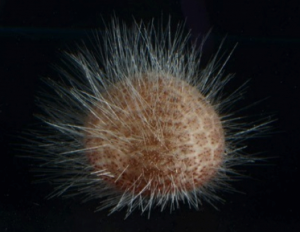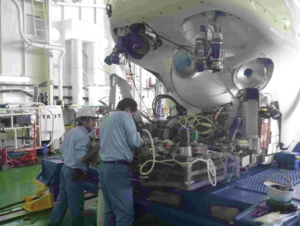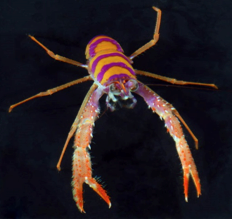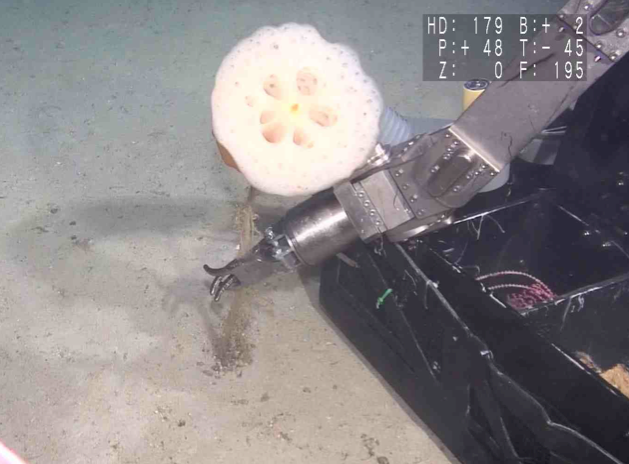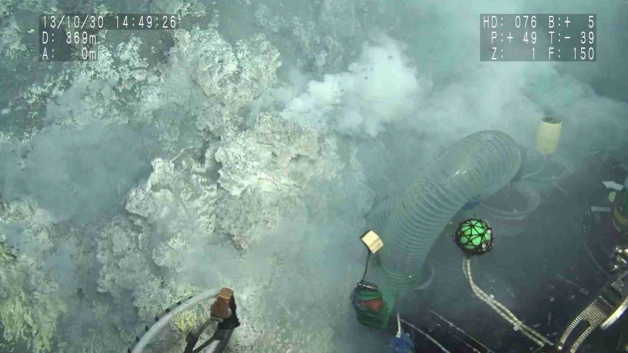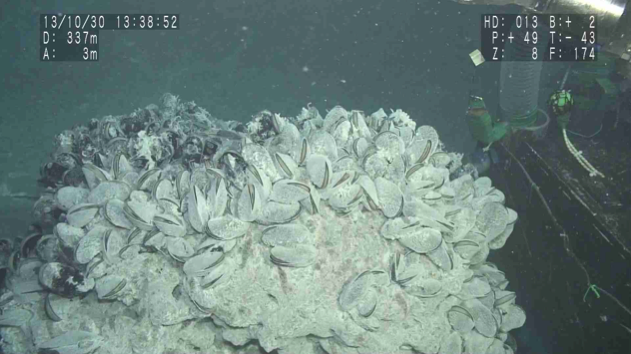Scientists Explore New Zealand s Deep Sea (Part II)
A photograph of a sea urchin sampled at 2244m from Canopus Seamount and captured by slurp gun. Image: JAMSTEC/NIWA
We made five planned dives during our voyage, each one a day long. It is a long day for the sub team. It takes several hours to prepare the submersible for the dive, and after seven to eight hours on the seafloor, another round of work is needed to prepare the sub for its next dive. We must remove the samples, download the data and clean and check the sub’s parts before it dives again.
Preparing Shinkai6500 for the first dive on Canopus Seamount. Image: JAMSTEC/NIWA
Good weather is a prerequisite for diving. Once below the ocean surface, the sub itself is fine, but the launching and retrieval process requires swells of less than two-and-a-half meters and very little wind.
Two of our dive days were lost and bad weather cut a third dive short. It can be frustrating, but at sea the weather has the ultimate say in what happens. On one of the occasions when we could not dive, we instead used a deep towed camera system to get a glimpse of the seafloor.
A colourful squat lobster (genus Babamunida) sampled at a depth of about 700 m near the base of Hinepuia Seamount. Image: JAMSTEC/NIWA
According to our final dive count, we completed one dive on Canopus Seamount (Louisville), one-and-a-half on Hinepuia Seamount (Kermadec) and a long camera transect on Osbourne Seamount (Louisville).
Malcolm was fortunate in that his first dive in the Shinkai 6500 got the green light. He had dived twice before in a U.S. submersible, but not to the depths expected on Canopus Seamount. As a result, we experienced a mixture of excitement and apprehension, as well as a feeling of responsibility: As with any dive there are 12 other scientists onboard; each with an extensive wish list of data and samples they hope to get during the dive.
Shinkai6500 sampling a stalked sponge at 1400m depth on Canopus Seamount. Image: JAMSTEC/NIWA
Canopus is a large volcano that, while very active for its first 10 million years, has been extinct for the last 60 million. As the Shinkai neared the seafloor, its eruptive birth was visible. Massive pillow lava flows came into sight and the pilots had to be careful to avoid overhanging rock walls and ledges as they started to move up the flanks of the seamount. The basaltic lava flows were very hard and defied most efforts to break off samples for the geologists. The biota were more forgiving, however, and we collected a variety of corals and sponges, the dominant animals attached to the exposed rock. Many were species that Malcolm could recognize from other surveys in New Zealand, but a number were unusual. These included a large slender sponge that was over two meters long (which we’ve since provisionally identified as Monoraphis sp) and a bright orange “tulip” Hyalonema sponge. As the dive progressed towards the summit, the species changed, with sea fans and golden corals becoming more frequent.
The vent site at Hinepuia Seamount. Image: JAMSTEC/NIWA
Hinepuia Seamount is very different from Canopus. It is known to be active, but the location of hydrothermal venting and the biological communities associated with it were previously unknown. During the first dive by veteran diver Shinji Tsuchida the dive was stopped early when the weather on the surface deteriorated. In hindsight, they had been tantalizingly close to finding the source of venting. A second dive, this time by Cornel de Ronde from GNS Science in New Zealand, lasted the full time, and by following a trail of dead clam shells the diver located a vent site at about 350 meters depth. The vent was 140 degrees Celsius, not high compared with black smoker type chimneys. Because temperature and depth are related, however, very hot conditions weren’t expected. The biological communities close to the vent sites were dominated by dense beds of bathymodiolid mussels, which have symbiotic bacteria that enable them to live in the chemically-rich waters. There were also high densities of a small symphurid flatfish that grazed on the bacteria associated with the sulphur deposits close to the vents. Further away from the venting, we found “normal” coral species; near the top of the seamount, we saw large numbers of fish cruising. These new data add considerably to our understanding of the similarities and differences between seamounts of the Kermadec Arc and fill in some valuable pieces of the jigsaw that sees such vents forming an almost continuous line around the western Pacific–the “ring of fire”–from New Zealand to Japan.
A bed of mussels on a rock near the vent site (the white colouration is from a layer of bacterial mat over the surface of the mussels). Image: JAMSTEC/NIWA
We still need to examine the hours of video footage we recorded and the various rock, biological, sediment and water samples we collected. However, given the limited number of dives, the survey was very successful in expanding our knowledge and understanding of deep-sea communities in the two seamount chain habitats. The voyage brought together a multidisciplinary research team, combined with state of the art submersible technology that highlighted the benefits of strong international cooperation and collaboration in science.
Follow Scientific American on Twitter @SciAm and @SciamBlogs. Visit ScientificAmerican.com for the latest in science, health and technology news.
© 2013 ScientificAmerican.com. All rights reserved.

